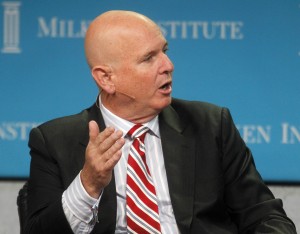
- New proposal increases size, scope of potential co-investments
- Secondary-market program would be able to take stakes in GPs
- PE program valued at $16.5 bln
California State Teachers’ Retirement System might overhaul parts of its private equity program to invest in larger and more complex co-investment and secondary-market transactions.
Under a proposal penned by Director of Private Equity Margot Wirth and Portfolio Manager Rob Ross, CalSTRS would establish a separately managed account with a firm specializing in co-investments to obtain access to larger, pre-syndication deals.
Staff would also be able to pursue more diverse pools of PE holdings via the secondary market — including stakes in private equity general partners.
It’s unclear to what extent CalSTRS plans to pursue stakes in GPs, but the policy proposal caps individual investments in management companies at $250 million.
“Staff has been increasing its exposure to secondary asset purchases through both secondary fund managers and co-investments,” Wirth and Ross wrote in their proposal. “Enabling staff to make a greater variety of secondary purchases will help staff reach its long-term allocation target faster with potentially reduced risk compared to committing exclusively to blind pools.”
Beyond expanding the scope of CalSTRS’s PE program, the proposal increases internal caps on the size of its commitments to PE, which vary depending on structure and strategy.
Its maximum re-up to a traditional leveraged buyout fund would grow 50 percent to $750 million, under the proposal. Investments in assets acquired through the secondary market would be capped at $1.5 billion per transaction, 15 times the maximum under its current policy [see CalSTRS Proposed PE investment policy changes].
The CalSTRS board will consider a draft of the proposal at its July 12 meeting, according to a copy published on the retirement system’s website. A second reading for the board is scheduled for November.
The board’s consultant, Meketa Investment Group, signed off on Wirth and Ross’s proposal in a memo included in the July 12 meeting materials.
CalSTRS and Meketa could not be reached for comment.
Bigger co-investments
CalSTRS, along with other large institutions, has placed greater emphasis on co-investments in recent years to bring down the cost of its PE program. Co-investments are often offered to LPs at zero or reduced fees, and GPs typically don’t charge carried interest on the investments.
Should the board approve the proposed changes later this year, CalSTRS’s maximum equity check for co-investments would double to $250 million. Staff would also be permitted to seek out and underwrite new deals prior to when they’re syndicated to other investors by the private equity firm leading the transaction.
Limited partners who co-underwrite deals alongside general partners typically receive larger allocations in the investment once the deal is syndicated, according to the proposal. Underwriting deals comes at a cost, however, and those LPs must pay their share of any expenses, should the deal collapse.
CalSTRS staff would develop a procedure for budgeting each deal’s potential diligence costs, according to the proposal, with each budget subject to the PE director’s approval.
Roughly 7 percent of the retirement system’s $16.5 billion PE portfolio was in co-investment assets, according to CalSTRS documents. The co-investment portfolio has netted a 7.9 percent return since its 1996 inception, according to an April report produced by Meketa.
Secondaries
CalSTRS has traditionally accessed the secondary market by making commitments to traditional secondary funds and co-investments, retirement system documents show.
Wirth and Ross’s proposal would expand the secondary program to include interests in GPs, separately managed accounts and portfolio companies — or a diversified pool of assets including any number of the above.
The proposal, if approved, would give staff the ability to invest as much as $1.5 billion in diversified pools of fund stakes or separate-account assets acquired through the secondary market. Diversified pools of co-investments, general partnership interests and portfolio companies would be capped at $500 million.
“Staff is continuously improving the sourcing and diligence process for primary funds, but is expanding its reach into secondary funds, [separately managed accounts], and co-investments,” according to an investment plan included in the July 12 meeting materials. “Staff has formed strategic relationships with managers to focus on elite venture, secondaries, and special mandates.”
CalSTRS’s investment portfolio was valued at $208.7 billion as of May 31.
Action Item: For more on CalSTRS: www.calstrs.com
Christopher Ailman, chief investment officer of California State Teachers Retirement System, speaks during a lunch panel, “Europe at a Crossroads,” at the Milken Institute Global Conference in Beverly Hills, California, on May 2, 2012. Photo courtesy Reuters/Fred Prouser


 If you do not receive this within five minutes, please try and sign in again. If the problem persists, please
email:
If you do not receive this within five minutes, please try and sign in again. If the problem persists, please
email: